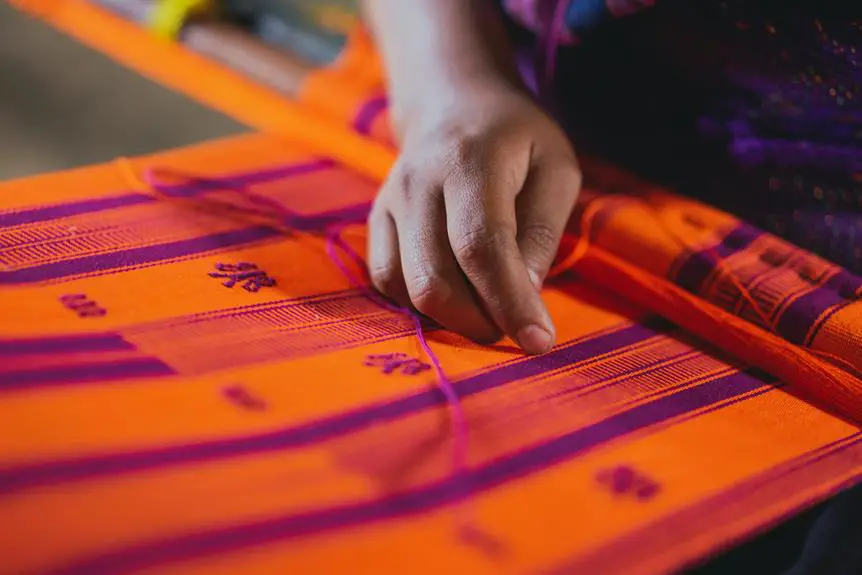When you're looking to print on various types of fabric, it's crucial to recognize each material's unique properties and how they impact the printing process. Whether you're working with cotton, silk, or synthetic blends, the right techniques and inks can make all the difference in achieving a vibrant and lasting print. You'll need to consider factors like ink absorption, durability, and heat settings. But before you get started, there are a few essential tools and methods you should be aware of that could significantly influence your results.
Table of Contents
Key Takeaways
- Choose the right fabric type, such as cotton for vibrant colors or polyester for durability, based on your project needs.
- Select appropriate printing methods; screen printing for bold designs, DTG for intricate images, and dye-sublimation for polyester.
- Use fabric-specific inks; water-based inks for cotton, silk-friendly inks for silk, and polyester inks for synthetic blends to ensure quality prints.
- Pre-treat fabrics when necessary to enhance ink adhesion and achieve better print results, especially for synthetic materials.
Understanding Fabric Types
When choosing fabric for printing, it's crucial to understand the different types available, as each one affects the quality and appearance of your print.
Cotton is a popular choice due to its absorbency and soft texture, making it ideal for vibrant colors. However, if you're looking for something with a bit more sheen, consider silk. Its smooth surface enhances print detail, but it can be delicate and requires special care.
Polyester is another great option, especially for those seeking durability and resistance to wrinkles. It holds color exceptionally well, making it perfect for bold designs. If you're working on projects that require stretch, like clothing, try spandex blends; they offer flexibility without sacrificing print quality.
For a more rustic feel, linen can give your prints a unique texture, but be mindful that its natural fibers may absorb ink differently.
Finally, synthetic fabrics like rayon can mimic the appearance of natural fibers while providing additional durability.
Tools and Materials Needed
To get started with printing on fabric, you'll need a few key tools and materials that ensure your project runs smoothly and achieves great results.
First, gather your fabric; cotton, polyester, and linen are popular choices. Next, you'll need a printer compatible with fabric printing, whether it's an inkjet or a specialized fabric printer.
You'll also want to stock up on fabric ink or transfer paper, depending on your chosen method. If you're using ink, ensure it's suitable for your fabric type. Don't forget to have some design software or templates ready for creating your prints.
In addition to these essentials, consider having a cutting mat, scissors, or a rotary cutter for precise fabric preparation. A ruler and fabric pins will help you align everything accurately.
You might also find a heat press or iron handy for setting your designs, especially if you're working with transfer paper.
Printing Techniques Overview
Various printing techniques can help you achieve stunning results on fabric, each offering unique advantages and effects.
One popular method is screen printing, where ink is pushed through a mesh stencil onto the fabric. This technique is great for bold designs and works well on various materials.
Direct-to-garment (DTG) printing is another option, ideal for intricate images and full-color designs. It uses specialized inkjet technology to print directly onto the fabric, producing high-quality results.
For a more traditional approach, you might consider block printing. This method involves carving designs into a block, inking it, and then stamping it onto the fabric. It's excellent for creating handcrafted, artisanal looks.
If you're interested in a more modern technique, sublimation might be your best bet. This involves turning solid dye into gas without going through a liquid state, allowing for vibrant, long-lasting prints that bond with polyester fabrics.
Lastly, heat transfer printing involves printing a design onto a special paper, then using heat to transfer it onto the fabric. It's versatile and great for one-off designs.
Choose the technique that best suits your project needs!
Printing on Cotton
Printing on cotton offers a soft, absorbent surface that beautifully showcases vibrant colors and intricate designs. To get started, choose high-quality cotton fabric for the best results. Pre-wash it to remove any sizing or chemicals, ensuring better ink adhesion. Once dry, iron out any wrinkles for a smooth printing surface.
Next, decide on your printing method. For smaller projects, screen printing provides excellent durability and color vibrancy. If you're looking for more detail and complexity, consider digital printing, which allows for intricate designs without the need for screens.
When it comes to ink, use fabric-specific inks to achieve lasting results. Water-based inks are a popular choice, as they're eco-friendly and easy to work with. Be sure to test your chosen ink on a scrap piece of fabric before diving into your main project.
After printing, heat-set the ink using an iron or heat press to ensure it bonds well with the cotton fibers. Finally, wash your printed fabric carefully to prevent fading.
Follow these steps, and you'll create stunning cotton prints that stand out and last!
Printing on Polyester
Polyester fabric offers a smooth, durable surface that's perfect for vibrant and long-lasting prints. When you decide to print on polyester, you'll want to consider a few key factors to achieve the best results. Firstly, choose the right printing method, such as dye sublimation or heat transfer, which works well with synthetic fibers.
Here are some tips to keep in mind:
- Pre-treatment: Always pre-treat the fabric to enhance ink adhesion.
- Ink selection: Use inks specifically designed for polyester to ensure color vibrancy.
- Temperature control: Set the right temperature and pressure during the printing process to avoid damaging the fabric.
- Post-print care: Wash and care for your printed polyester items according to specific instructions to maintain the quality.
Printing on Silk
When it comes to fabric printing, silk presents a unique set of qualities that can elevate your designs with its luxurious texture and sheen.
To get started, you'll want to choose the right printing method. Dye-sublimation is a popular choice for silk, as it allows the dye to penetrate the fibers, resulting in vibrant colors and a soft feel.
Before you print, make sure to pre-treat your silk fabric to enhance dye absorption. A gentle wash can remove any residues, ensuring better ink adhesion. If you're using an inkjet printer, opt for ink specifically designed for silk. This prevents fading and ensures your designs maintain their brilliance.
It's crucial to set the right temperature and pressure when pressing the fabric, as silk is delicate. A heat press at low temperatures is ideal to avoid damaging the fibers. After printing, always allow the fabric to cool and cure properly to ensure longevity.
Lastly, remember to hand wash your printed silk to maintain its quality. Avoid harsh detergents, and line dry it to keep that luxurious sheen intact.
With these tips, you can create stunning silk prints that truly stand out.
Printing on Canvas
When you're printing on canvas, choosing the right printing techniques and inks is crucial for achieving the best results.
Different methods can impact the texture and vibrancy of your design, so it's important to consider what suits your project.
Let's explore the options that will make your canvas prints stand out.
Best Printing Techniques
For vibrant results on canvas, you'll want to explore techniques like inkjet printing, screen printing, and heat transfer methods. Each method has its unique advantages, giving you flexibility based on your project's needs.
Inkjet Printing: Great for detailed images and photographs. It allows you to produce high-quality prints with rich colors.
Screen Printing: Ideal for bold designs and larger quantities. It's durable and offers excellent color saturation, making it perfect for custom artwork.
Heat Transfer: Suitable for intricate designs, especially with multiple colors. You can easily apply it to various surfaces, but it may not be as long-lasting as other methods.
Direct-to-Garment (DTG): Perfect for small runs and complex designs. It uses specialized inkjet technology to print directly onto the canvas.
Sublimation Printing: Best for polyester canvas. This technique infuses dye into the fabric, resulting in vibrant, long-lasting prints.
Choosing the right printing technique depends on your design, budget, and the intended use of your canvas. By understanding each method, you can achieve the best results for your creative projects.
Choosing Suitable Inks
Selecting the right ink is key to achieving vibrant and durable prints on canvas, complementing the printing technique you've chosen. When printing on canvas, you generally have two primary ink options: pigment-based and dye-based inks.
Pigment-based inks are your best bet for long-lasting prints. They resist fading and are water-resistant, making them ideal for artwork and high-quality reproductions. Plus, pigment inks adhere well to the canvas surface, ensuring sharp details and rich colors.
On the other hand, dye-based inks can produce brighter colors but may not be as durable. They tend to fade over time and can bleed if exposed to moisture. If you're looking for a more temporary solution or vibrant designs for indoor use, dye-based inks might work, but keep in mind the limitations.
Ultimately, consider your project's purpose and the expected exposure to light and moisture. Choosing the right ink won't only impact the final appearance but also the longevity of your prints. Make sure to test your selected inks on a small canvas piece beforehand to ensure they meet your expectations!
Frequently Asked Questions
Can I Print on Stretchy Fabrics Like Spandex?
Yes, you can print on stretchy fabrics like spandex. Just make sure to use the right printer settings and ink suited for the material. Test on a small piece first to ensure good results.
How Do I Wash Printed Fabrics Without Fading?
To wash printed fabrics without fading, always use cold water and gentle cycles. Turn items inside out, avoid bleach, and hang them to dry. These steps help maintain the vibrancy of your prints.
What Is the Best Ink for Fabric Printing?
When choosing ink for fabric printing, you'll want to consider fabric type and desired durability. Water-based inks are great for softness, while pigment inks offer vibrant colors. Test samples to find what suits your project best.
Can I Print on Fabrics With Waterproof Coatings?
You can print on waterproof-coated fabrics, but it's tricky. The coating often prevents ink adhesion. You might need specialized inks or surface treatments to ensure the ink sticks properly and delivers quality results.
How to Fix Mistakes in Fabric Printing?
To fix mistakes in fabric printing, you can either carefully remove the ink with a solvent, reprint the design after correcting errors, or creatively incorporate the mistake into your final project for a unique touch.
- How Does Ring Spun Cotton Affect Garment Fit and Shape Retention? - August 13, 2024
- What Are the Challenges in Producing Ring Spun Cotton? - August 13, 2024
- Is Ring Spun Cotton Suitable for Plus-Size Clothing? - August 13, 2024







